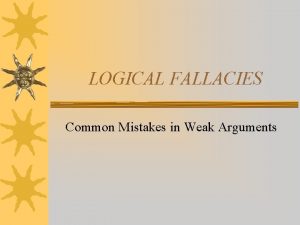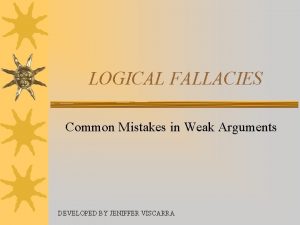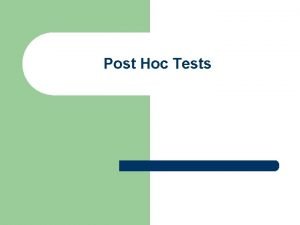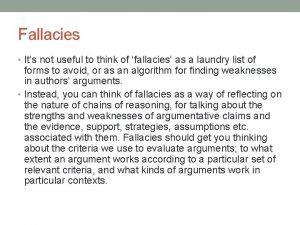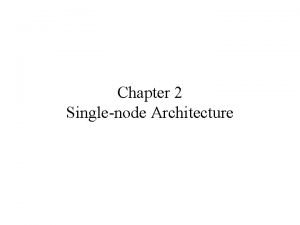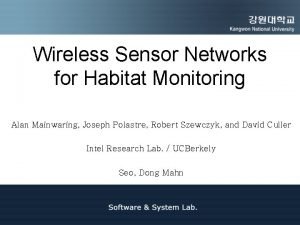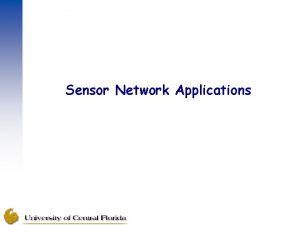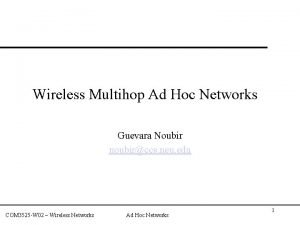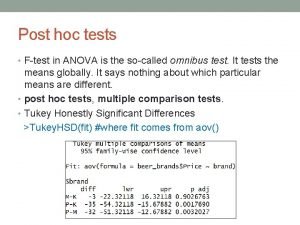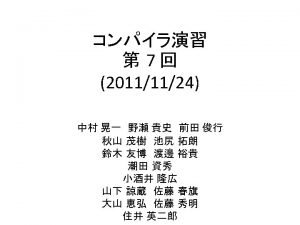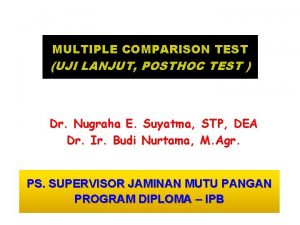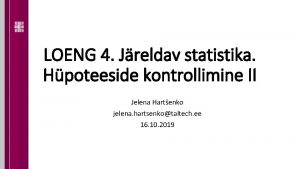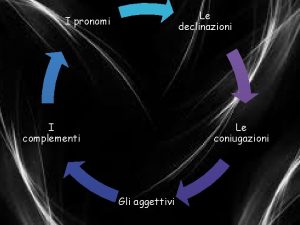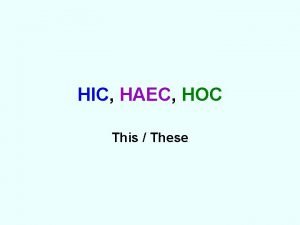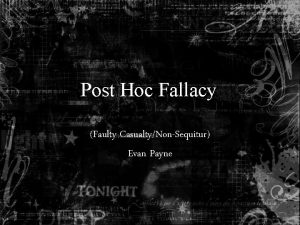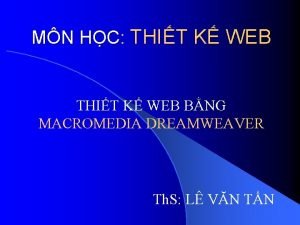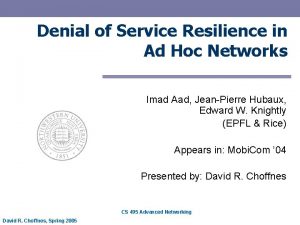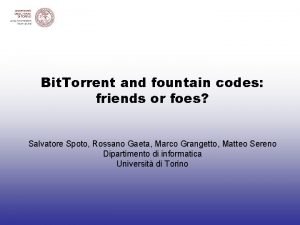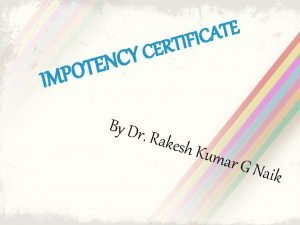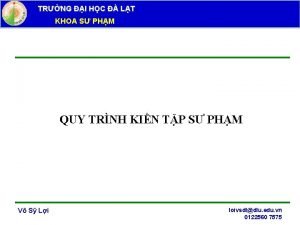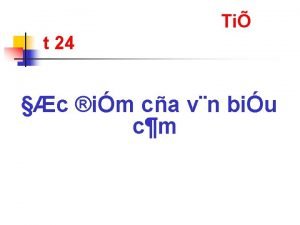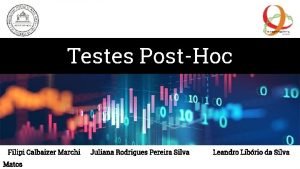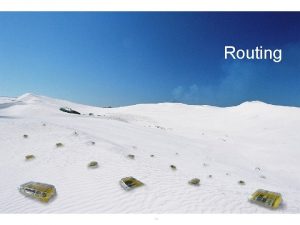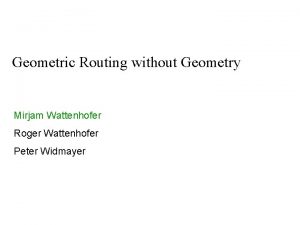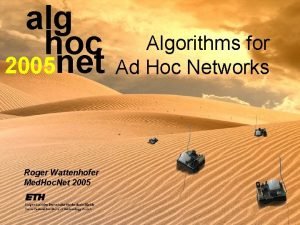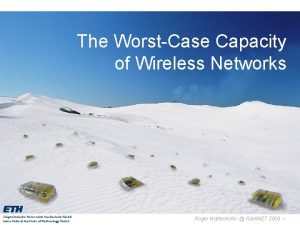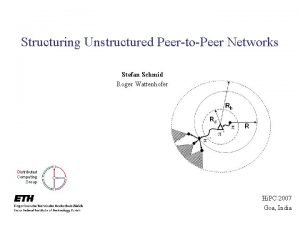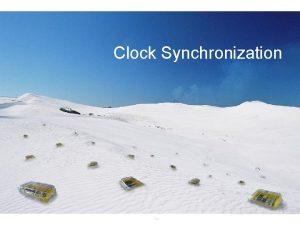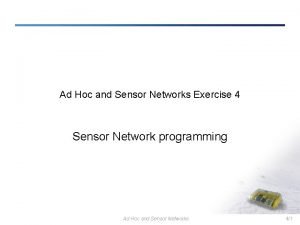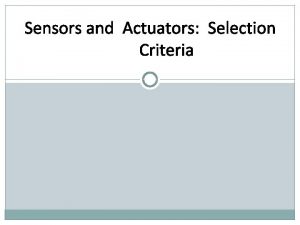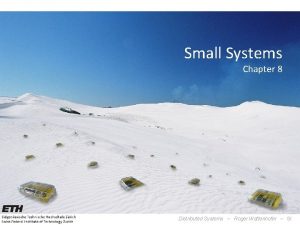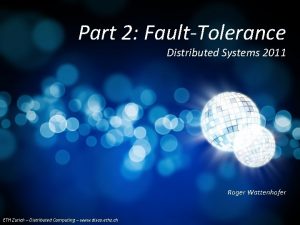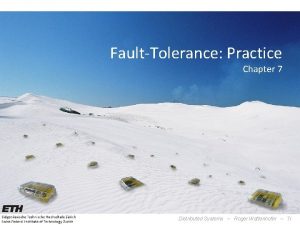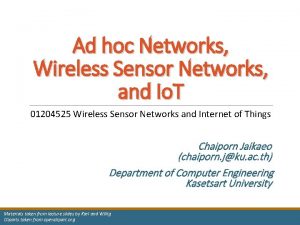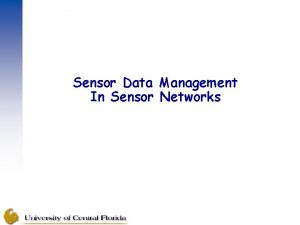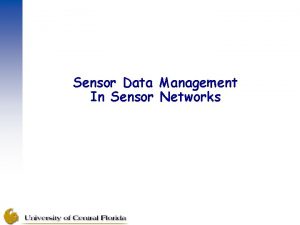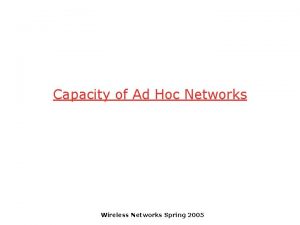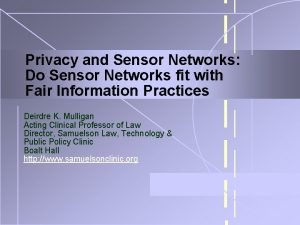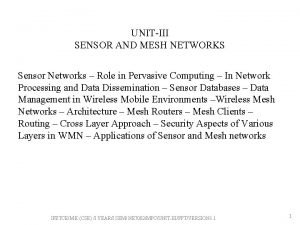Capacity Ad Hoc and Sensor Networks Roger Wattenhofer
























![This works in practice! [Moscibroda et al. , Hotnets 2006] • Measurements using mica This works in practice! [Moscibroda et al. , Hotnets 2006] • Measurements using mica](https://slidetodoc.com/presentation_image_h2/656fb3310bc2924b4d23a968e46cf55a/image-25.jpg)
























- Slides: 49

Capacity Ad – Hoc and Sensor Networks – Roger Wattenhofer – 12/

Overview • • • Capacity and Related Issues Protocol vs. Physical Models Capacity in Random Network Topologies Achievable Rate of Sensor Networks Scheduling Arbitrary Networks Ad – Hoc and Sensor Networks – Roger Wattenhofer – 12/2

Fundamental Questions • • How much communication can you have in a wireless network? How long does it take to meet a given communication demand? How much spatial reuse is possible? What is the capacity of a wireless network? • Many modeling issues are connected with these questions. • You can ask these questions in many different ways that all make perfect sense, but give different answers. • In the following, we look at a few results in this context, unfortunately only superficially. Ad – Hoc and Sensor Networks – Roger Wattenhofer – 12/3

Motivation • Spatial capacity is an indicator of the “data intensity” in a transmission medium. • The capacity of some well-known wireless technologies – – IEEE 802. 11 b Bluetooth IEEE 802. 11 a Ultra-wideband 1, 000 bit/s/m² 30, 000 bit/s/m² 83, 000 bit/s/m² 1, 000 bit/s/m² • The wireless capacity is a function of the physical layer characteristics such as available bandwidth or frequency, but also how well the protocols on top of the physical layer are implemented, in particular media access. As such capacity is a theoretical framework for MAC protocols. Ad – Hoc and Sensor Networks – Roger Wattenhofer – 12/4

Protocol Model • For lower layer protocols, a model needs to be specific about interference. A simplest interference model is an extension of the UDG. In the protocol model, a transmission by a node in at most distance 1 is received iff there is no conflicting transmission by a node in distance at most R, with R ¸ 1, sometimes just R = 2. + Easy to explain – Inherits all major drawbacks from the UDG model – Does not easily allow for designing distributed algorithms/protocols – Lots of interfering transmissions just outside the interference radius R do not sum up Ad – Hoc and Sensor Networks – Roger Wattenhofer – 12/5

Hop Interference (HI) • An often-used interference model is hop-interference. Here a UDG is given. Two nodes can communicate directly iff they are adjacent, and if there is no concurrent sender in the k-hop neighborhood of the receiver (in the UDG). Sometimes k = 2. • Special case of the protocol model, inheriting all its drawbacks + Simple + Allows for distributed algorithms – A node can be close but not produce any interference (see picture) Ad – Hoc and Sensor Networks – Roger Wattenhofer – 12/6

Physical (SINR) Model • We look at the signal-to-noise-plus-interference (SINR) ratio. • Message arrives if SINR is larger than at receiver Power level of sender u Path-loss exponent, ® = 2, . . . , 6 Noise Distance between transmitter w and receiver v Minimum signal-tointerference ratio, depending on quality of hardware, etc. • Mind that the SINR model is far from perfect as well. Ad – Hoc and Sensor Networks – Roger Wattenhofer – 12/7

SINR Discussion + The SINR model allows for interference that does sum up. This is certainly closer to reality. However, SINR is not reality. In reality, e. g. , competing transmissions may even cancel themselves, and produce less interference. In that sense the SINR model is pessimistic (interference summing up). – SINR is “complicated”, hard to analyze – SINR does not really allow for distributed algorithms – Also, in reality, e. g. the signal fluctuates over time. Some of these issues are captured by more complicated fading channel models. Ad – Hoc and Sensor Networks – Roger Wattenhofer – 12/8

More on SINR • Often there is more than a single threshold ¯, that decides whether reception is possible or not. • However, even more is possible: For example, assume that a receiver is receiving two signals, signal S 1 being much stronger than signal S 2. Then S 2 has a terrible S/N ratio. However, we might be able to “subtract” the strong S 1 from the total signal, and with “S – S 1 = S 2” also get S 2. Ad – Hoc and Sensor Networks – Roger Wattenhofer – 12/9

Measures for Network Capacity • Throughput capacity – Number of successful packets delivered per time – Dependent on the traffic pattern – E. g. : What is the maximum achievable, over all protocols, for a random node distribution and a random destination for each source? • Transport capacity – Network transports one bit-meter when one bit has been transported a distance of one meter – Number of bit-meters transported per second – What is the maximum achievable, over all node locations, and all traffic patterns, and all protocols? Ad – Hoc and Sensor Networks – Roger Wattenhofer – 12/10

Transport Capacity • n nodes are arbitrarily located in a unit disk • We adopt the protocol model with R=2, that is a transmission is successful if and only if the sender is at least a factor 2 closer than any interfering transmitter. In other words, each node transmits with the same power, and transmissions are in synchronized slots. • What configuration and traffic pattern will yield the highest transport capacity? • Idea: Distribute n/2 senders uniformly in the unit disk. Place the n/2 receivers just close enough to senders so as to satisfy the threshold. Ad – Hoc and Sensor Networks – Roger Wattenhofer – 12/11

Transport Capacity: Example sender receiver Ad – Hoc and Sensor Networks – Roger Wattenhofer – 12/12

Transport Capacity: Understanding the example • Sender-receiver distance is £(1/√n). Assuming channel bandwidth W [bits], transport capacity is £(W√n) [bit-meter], or per node: £(W/√n) [bit-meter] • Can we do better by placing the sourcedestination pairs more carefully? Not really: Having a sender-receiver pair at distance d inhibits another receiver within distance up to 2 d from the sender. In other words, it kills an area of £(d 2). d • We want to maximize n transmissions with distances d 1, d 2, …, dn given that the total area is less than a unit disk. This is maximized if all di = £(1/√n). So the example was asymptotically optimal. Ad – Hoc and Sensor Networks – Roger Wattenhofer – 12/13

More capacities… • The throughput capacity of an n node random network is • There exist constants c and c‘ such that • Transport capacity: – Maximized when nodes transmit to neighbors • Throughput capacity: – Near-optimal when nodes transmit to neighbors • In one sentence: local communication is better. . . Ad – Hoc and Sensor Networks – Roger Wattenhofer – 12/14

Even more capacities… • Similar claims hold in the physical (SINR) model as well… • Results are unchanged even if the channel can be broken into subchannels • There are literally thousands of results on capacity, e. g. – on random destinations – on power-law traffic patterns (probability to communicate to a close-by destination is higher) – communication through relays – communication in mobile networks – etc. • Problem: The model assumptions are sometimes quite optimistic, if not unrealistic… • Q: What is the capacity of non-random networks? Ad – Hoc and Sensor Networks – Roger Wattenhofer – 12/15

Data Gathering in Wireless Sensor Networks • Data Gathering & Aggregation – – – • Classic application of sensor networks Sensor nodes periodically sense environment Relevant information needs to be transmitted to sink Functional Capacity of Sensor Networks – – Sink periodically wants to compute a function fn of sensor data At what rate can this function be computed? (1) fn , fn(2), fn(3) sink Ad – Hoc and Sensor Networks – Roger Wattenhofer – 12/16

The Simple Round-Robin Scheme • Each sensor reports its results directly to the sink (one after another). Sink can compute one function per n rounds Achieves a rate of 1/n sink x 1=7 x 2=6 (1) x 3=4 fn (2) fn x 4=3 (3) x 8=5 fn (4) fn t x 7=9 x 5=1 x 6=4 x 9=2

Is there a better scheme? !? sink (1) fn (2) fn (3) fn (4) fn t • Multi-hop relaying • In-network processing • Spatial Reuse – # concurrent transmissions • Pipelining • …? !?

Capacity in Wireless Sensor Networks At what rate can sensors transmit data to the sink? Scaling-laws how does rate decrease as n increases…? (1/n) Answer depends on • Function to be computed • Coding techniques • Network topology • Wireless model (1/√n) (1/log n) (1) Only simple functions (max, min, avg, …) No network coding Ad – Hoc and Sensor Networks – Roger Wattenhofer – 12/19

Practical relevance? • Efficient data gathering! • Efficient MAC layer! • This (and related) problem is studied theoretically: The Capacity of Wireless Networks Gupta, Kumar, 2000 [Arpacioglu et al, IPSN’ 04] [Giridhar et al, JSAC’ 05] [Barrenechea et al, IPSN’ 04] [Grossglauser et al, INFOCOM’ 01] [Liu et al, INFOCOM’ 03] [Toumpis, TWC’ 03] [Gamal et al, INFOCOM’ 04] [Kyasanur et al, MOBICOM’ 05] [Kodialam et al, MOBICOM’ 05] [Li et al, MOBICOM’ 01] [Mitra et al, IPSN’ 04] [Bansal et al, INFOCOM’ 03] [Yi et al, MOBIHOC’ 03] [Gastpar et al, INFOCOM’ 02] [Zhang et al, INFOCOM’ 05] [Dousse et al, INFOCOM’ 04] [Perevalov et al, INFOCOM’ 03] etc…

Network Topology? • Almost all capacity studies so far make very strong assumptions on node deployment, topologies Wh – randomly, uniformly distributed nodes loo at if a ks d n – nodes placed on a grid iffe etwor ren tly… k – etc. ?

Capacity for Arbitrary/Worst-Case Network Topologies • What can one say about worst-case node distributions? • What can one say about arbitrary node distributions? Real Capacity How much information can be transmitted in any network? “Classic” Capacity Worst-Case Capacity How much information can be transmitted in nice networks? How much information can be transmitted in nasty networks? Ad – Hoc and Sensor Networks – Roger Wattenhofer – 12/22

Wireless Models • Several models for wireless communication – – Connectivity-only models (e. g. UDG, QUDG, BIG, UBG, etc. ) Interference models – Protocol models – – – Physical models – – – • Two Radii model with constant power (e. g. UDG with interference radius R=2). Nodes may use power control (transmission and interference disks of different size) SINR with constant power (every node transmitting with the same power) SINR with power control (nodes can choose power) Etc. Premise: Fundamental results should not depend on model! – – And indeed, classical capacity (assuming e. g. random or regular node distribution) results are similar in all the models above Are there any examples where results depend on model? ! Ad – Hoc and Sensor Networks – Roger Wattenhofer – 12/23

Simple Example A sends to D, B sends to C: C B A 4 m 1 m D 2 m Assume a single frequency (and no fancy decoding techniques!) Is spatial reuse possible? NO In almost all models… YES SINR w/ power control Let =3, and N=10 n. W Transmission powers: PB= -15 d. Bm and PA= 1 d. Bm SINR of A at D: SINR of B at C: Ad – Hoc and Sensor Networks – Roger Wattenhofer – 12/24
![This works in practice Moscibroda et al Hotnets 2006 Measurements using mica This works in practice! [Moscibroda et al. , Hotnets 2006] • Measurements using mica](https://slidetodoc.com/presentation_image_h2/656fb3310bc2924b4d23a968e46cf55a/image-25.jpg)
This works in practice! [Moscibroda et al. , Hotnets 2006] • Measurements using mica 2 nodes • Replaced standard MAC protocol by a (tailor-made) „SINR-MAC“ • Measured for instance the following deployment. . . u 1 • u 2 u 3 u 4 u 5 Time for successfully transmitting 20, 000 packets: Speed-up is almost a factor 3 u 6

Worst-Case Rate in Sensor Network: Protocol Model • • Topology (worst-case!): Exponential node chain Model: Protocol model, with power control – Assume for simplicity that the interference radius is twice the transmission radius (however, this can be relaxed easily) sink xi d(sink, xi) = (1+1/ )i-1 • • • Whenever a node transmits to another node all nodes to its left are in its interference range. In other words, no two nodes can transmit. Network behaves like a single-hop network! Same result for SINR with constant power or P ~ d®. In the protocol model, the achievable rate is (1/n).

Physical Model with Power Control In the physical model, the achievable rate is (1/polylog n), independent of the network topology. • • Original result was (1/log 3 n). [Moscibroda et al, Infocom 2006] Later improved to (1/log 2 n). [Moscibroda, IPSN 2007] • • Algorithm is centralized, complex not practical But it shows that high rates are possible even in worst-case networks • Basic idea: Enable spatial reuse by exploiting SINR effects. Ad – Hoc and Sensor Networks – Roger Wattenhofer – 12/27

Scheduling Algorithm – High Level Procedure • • High-level idea is simple Construct a hierarchical tree T(X) that has desirable properties if r lim d te we jus po ad on be issi n Ca nsm tra 1) Initially, each node is active 2) Each node connects to closest active node 3) Break cycles yields forest 4) Only root of each tree remains active loop until no active nodes d ite Phase Scheduler: How to schedule T(X)? The resulting structure has some nice properties If each link of T(X) can be scheduled at least once in L(X) time-slots Then, a rate of 1/L(X) can be achieved

Scheduling Algorithm – Phase Scheduler How to schedule T(X) efficiently We need to schedule links of different magnitude simultaneously! Only possibility: senders of small links must overpower their receiver! R(x) x d Subtle balance is needed! • • • 1) If we want to schedule both links… … R(x) must be overpowered Must transmit at power more than ~d 2) If senders of small links overpower their receiver… … their “safety radius” increases (spatial reuse smaller)

Scheduling Algorithm – Phase Scheduler 1) Partition links into sets of similar length small 2) Group sets such that links a and b in two sets in the same group have at least da ¸ (c )c( a- b) ¢db =3 large Factor 2 between two sets =2 =1 Each link gets a ij value Small links have large ij and vice versa Schedule links in these sets in one outer-loop iteration Intuition: Schedule links of similar length or very different length 3) Schedule links in a group Consider in order of decreasing length (I will not show details because of time constraints. ) Together with structure of T(x) (1/log 3 n) bound Ad – Hoc and Sensor Networks – Roger Wattenhofer – 12/30

Rate in Wireless Sensor Networks: Summary Networks Model Max. rate in arbitrary, worst-case deployment Traditional Capacity Max. rate in random, uniform deployment protocol model or no power control (1/n) (1/log n) physical model with power control (1/log 2 n) (1/log n) Exponential gap between protocol and physical model! [Giridhar, Kumar, 2005] Worst-Case Capacity The Price of Worst-Case Node Placement - Exponential in protocol model - Polylogarithmic in physical model (almost no worst-case penalty!) 31

Possible Applications – Improved “Channel Capacity” • Consider a channel consisting of wireless sensor nodes • What is the throughput-capacity of this channel. . . ? time Channel capacity is 1/3

Possible Applications – Improved “Channel Capacity” • A better strategy. . . • Assume node can reach 3 -hop neighbor time Channel capacity is 3/7

Possible Applications – Improved “Channel Capacity” • All such (graph-based) strategies have capacity strictly less than 1/2! • For certain and , the following strategy is better! time Channel capacity is 1/2

Possible Application – Hotspots in WLAN • Traditionally: clients assigned to (more or less) closest access point far-terminal problem hotspots have less throughput Y X Z

Possible Application – Hotspots in WLAN • Potentially better: create hotspots with very high throughput • Every client outside a hotspot is served by one base station Better overall throughput – increase in capacity! Y X Z

Beyond Worst-/Best-Case: Scheduling Arbitrary Links? • Given: A set of arbitrary communication requests in the plane – Each request is defined by position of source and destination – Each communication request has the same demand; if some request has a higher demand, just add links between the same sender/receiver – Just single-hop, no forwarding at intermediate nodes – Model: SINR with constant power • Goal: Minimize the time to schedule all links! – Those scheduled in the same time slot must obey SINR constraints 8 4 1 2 7 3 5 6 • Example needs 3 time slots: 1, 4, 7 and 2, 3, 6 and 5, 8 Ad – Hoc and Sensor Networks – Roger Wattenhofer – 12/37

Some Results • Just checking whether some links can be scheduled in the same time slot is trivial. Simply test the SINR at each receiver. • On the other hand, scheduling all links in minimum time is difficult (NP-complete), even with constant power. [Goussevskaia et al. , 2007] – With power control, the complexity of scheduling is still unknown. • What about approximation algorithms? Is it easy to schedule the maximum number of links in one slot? How much time do you need to deliver a given communication demand? – Some models are known, others not… Ad – Hoc and Sensor Networks – Roger Wattenhofer – 12/38

The problem Ad – Hoc and Sensor Networks – Roger Wattenhofer – 12/39

Definition: Affectance • The „affectance“ of link lv , caused by a set of links S, is the sum of the relative interferences of the links in S on lv. This can even be scaled with noise, using an additional constant ´v. We have: Interference of w on v with and Signal from sender v • (We simplify by omitting noise. This gives ´v = ¯. ) • A set S is SINR-feasible iff for all lv in S we have alv (S) · 1. • Affectance is additive, i. e. alv (S 1) + alv (S 2) = alv (S 1 + S 2) Ad – Hoc and Sensor Networks – Roger Wattenhofer – 12/40

One-Slot Scheduling with Fixed Power Levels • Given a set L={l 1, …, ln} of arbitrary links, we want to maximize the number of links scheduled in one time-slot • Constant approximation algorithm: Schedule “strong” links first – Input: L; Output: S; – Repeat Constant c>2, c=f(α, β) – Add shortest link lv in L to S; Links with receivers sw – Delete all lw in L, where dwv ≤ c¢dvv; too close to sender rv – Delete all lw in L, where a. S(lw) ≥ 2/3; Links with high – Until L=ø; affectedness* – Return S;

One-Slot Scheduling: Correctness Proof • We need to prove affectedness a. S(lv) ≤ 1 for all lv in S Sv-: set of shorter (≤) links in S, i. e. , added before lv Sv+: set of longer (≥) links in S, i. e. , added after lv a. Sv-(lv) ≤ 2/3 (OK! by algo) a. Sv+(lv) ≤ 1/3 (? See below!) • All senders in set Sv+ have pairwise distance ± = (c-1)dvv. • We partition the space in infinitely many rings of thickness ±. – – – There is no sender in Sv+ in circle R 0 A sender in ring Rk has at least distance k± R 2 The number of senders in ring Rk is O(k) Affectedness from ring Rk is O(¯k 1 -®±-®) Total affectedness is O(§k¸ 1¯k 1 -®±-®) · 1/3, for ® > 2 and large enough constant c = f(α, β) R 1 ± rv ± … Rk

One-Slot Scheduling: Approximation Proof • Count the number of links deleted by ALG that could have been scheduled in the optimum solution OPT: OPT’ = OPT ALG OPT’ = OPT 1 + OPT 2 OPT 1: links deleted in step 1 OPT 2: links deleted in step 2 • Claim 1: |OPT 1| ≤ ½ 1|ALG|, with ½ 1 = f(c) • Proof: If the optimal wants to schedule more than ½ 1 links around receiver rv, then two of these links have to be very close, and would not satisfy the SINR condition (since their length is at least the length of link lv). rv cdvv

Helper Lemma: Blue-Dominant Centers Lemma • Consider two disjoint sets B and R of blue and red points in the plane. If |B| > 5 q|R| then at least one point b in B is q-blue-dominant. Definition: a point b in B is q-blue-dominant (q in Z+) if, for every ball of radius d around b, there are q times more blue than red points. • Proof: for each red point r in R, remove q “guarding sets” of r, i. e. , q times the 5 closest blue points in all directions. • After processing all the red points, at least one blue point b* is left, since |B| > 5 q|R|. Point b* is blue-dominant, since all red points in R are “guarded” by at least q blue points from all directions.

One-Slot Scheduling: Approximation Proof (Part 2) • Claim 2: |OPT 2| ≤ ½ 2|ALG|, ½ 2=10 – Proof: Let B = OPT 2 (senders) and R = ALG (senders also) – Assume for the sake of contradiction that |B|>10|R|. – By the blue dominant centers lemma, there is a 2 -blue-dominant point b in OPT 2. Since b is 2 -blue-dominant, it is twice as much affected by OPT 2 than by ALG. (Really, it is the receiver of link lb that is affected but thanks to the clearing of the neighborhood, the receiver is “close” to the sender; some nasty details omitted). – In other words, we have a. ALG(lb) < ½¢a. OPT 2(lb). With a. OPT 2(lb) ≤ 1 we have a. ALG(lb) < ½. This contradicts that link lb has been deleted by step 2 of the algorithm, since step 2 only deletes links with a. S(lb) ≥ 2/3. • In summary, (½ 1+½ 2)¢|ALG| ¸ |OPT 1| + |OPT 2| = |OPT’| = |OPT ALG| ¸ |OPT| – |ALG|. That is, |ALG| ¸ |OPT| /(½ 1+½ 2+1) = (|OPT|).

SINR Robustness • Given a set of scheduling requests S. We can schedule the set in T time, iff we can partition the set in T SINR-feasible subsets S 1, …, ST • What happens if we change the parameters a bit, e. g. what if we now need to deal with a different ¯? Can it be that changing ¯ by some constant factor will lead to a totally different solution? • In general, what if the world is not perfect? ! – What if antennas are not perfectly omnidirectional? – What if signals are not perfectly summing up? – What if signal-to-noise ratio is not perfectly equal to ¯? • Luckily the SINR model is robust against minor (constant) changes Ad – Hoc and Sensor Networks – Roger Wattenhofer – 12/46

General Robustness Algorithm • A set S is SINRÁ-feasible iff for all lv in S we have alv (S) · Á. A schedule is SINRÁ-feasible if all its slots are SINRÁ-feasible. – This generalized feasibility essentially covers all model changes • From a SINR-feasible schedule to a SINRÁ-feasible schedule: 1. For each slot S in a SINR-feasible schedule, process links of S in decreasing order of their length, i. e. , l 1, l 2, …, lk 2 S, with lv ¸ lv +1. For each link lv , assign lv to Sj with minimum j with alv (Sj) · Á/2. Then, the affectance on lv by longer links is at most Á/2. By additivity of affectance, the number of sets is at most d 2/Áe. 2. For each set Sj, do the process in reverse order (short links first), getting sets Sj 1, Sj 2, …, Sjk. Now, the affectance on lv by shorter links is at most Á/2. Thus, the total affectance is at most Á for each link. Also each original set S is partitioned into at most d 2/Áe 2 sets. Ad – Hoc and Sensor Networks – Roger Wattenhofer – 12/47

SINR Robustness Discussion • We have constructively shown: If we can schedule a set of links in T slots in SINR, then we need at most O(T/Á2) slots if we adapt the model by a factor Á < 1. – – This also holds if the scenario is “mixed”, e. g. , if some antennas are a factor Á stronger than others, or if the antenna gain in one direction is a factor Á stronger, or if walls dampen transmissions by a factor Á. • In other words, if Á is constant, the SINR model is robust as solutions will continue to be valid up to constant factors. Ad – Hoc and Sensor Networks – Roger Wattenhofer – 12/48

Open problem • This is an area with more open than closed problems. The biggest open problem is scheduling with power control. Formally, the problem can be defined as follows: • A communication request consists of a source and a destination, which are arbitrary points in the Euclidean plane. Given n communication requests, assign a color (time slot) to each request. For all requests sharing the same color specify power levels such that each request can be handled correctly, i. e. , all colors are SINRfeasible. The goal is to minimize the number of colors. • Pretty much nothing is known about this problem. Ad – Hoc and Sensor Networks – Roger Wattenhofer – 12/49
 Wattenhofer eth
Wattenhofer eth Fallacy of affirming the consequent
Fallacy of affirming the consequent Flawed logic definition
Flawed logic definition What is false analogy
What is false analogy Strawman fallacy example
Strawman fallacy example Post hoc ergo proter hoc
Post hoc ergo proter hoc Hic haec hoc latin chart
Hic haec hoc latin chart Post hoc test
Post hoc test Post hoc ergo procter hoc
Post hoc ergo procter hoc Bluetooth based smart sensor network
Bluetooth based smart sensor network Single node architecture in wsn
Single node architecture in wsn Wireless sensor networks for habitat monitoring
Wireless sensor networks for habitat monitoring Bluetooth based smart sensor networks
Bluetooth based smart sensor networks Wireless sensor networks for habitat monitoring
Wireless sensor networks for habitat monitoring Difference between virtual circuit and datagram network
Difference between virtual circuit and datagram network Production units have an optimal rate of output where:
Production units have an optimal rate of output where: Basestore iptv
Basestore iptv A priori comparisons
A priori comparisons Ad hoc vs infrastructure
Ad hoc vs infrastructure 5 phẩm chất của học sinh
5 phẩm chất của học sinh Ad hoc budget
Ad hoc budget Cấu tạo kính tiềm vọng
Cấu tạo kính tiềm vọng Mâu thuẫn cơ bản trong quá trình dạy học
Mâu thuẫn cơ bản trong quá trình dạy học Assumption of anova
Assumption of anova Ad-hoc polymorphism
Ad-hoc polymorphism Omyl post hoc
Omyl post hoc Multiple comparison adalah
Multiple comparison adalah Ad hoc vs infrastructure
Ad hoc vs infrastructure Bài việt hang sơn đoòng tin học lớp 5
Bài việt hang sơn đoòng tin học lớp 5 Hii ruut statistik
Hii ruut statistik Declinazione ipse ipsa ipsum
Declinazione ipse ipsa ipsum Haec cena est optima
Haec cena est optima Hi hae haec
Hi hae haec Ad hoc analysis excel
Ad hoc analysis excel Cấu tạo xinap hóa học
Cấu tạo xinap hóa học Adsystech
Adsystech Ad hoc testable design techniques
Ad hoc testable design techniques Post hoc fallacy definition
Post hoc fallacy definition Nhập môn giải phẫu học
Nhập môn giải phẫu học Học thiết kế web bằng dreamweaver 8
Học thiết kế web bằng dreamweaver 8 Klam kompozicie
Klam kompozicie Aad hoc
Aad hoc Friends torrent
Friends torrent Impotence quad hoc
Impotence quad hoc Của văn bản tôi đi học
Của văn bản tôi đi học Khoa sư phạm đại học đà lạt
Khoa sư phạm đại học đà lạt Lập công thức hóa học của ca2 với oh1
Lập công thức hóa học của ca2 với oh1 Các phương thức biểu đạ
Các phương thức biểu đạ Tabela tukey
Tabela tukey The cat and the mice story writing
The cat and the mice story writing


